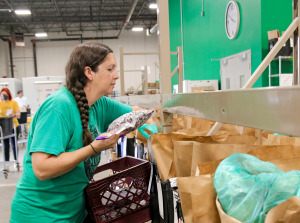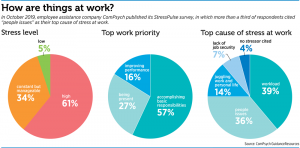Subscriber Benefit
As a subscriber you can listen to articles at work, in the car, or while you work out. Subscribe Now
In the workplace, human energy burns to accomplish tasks and increase efficiency. But one danger of burning is the possibility of burning out.
Leaders at Indianapolis-based USA Track & Field, Emmis Communications and Market Wagon use different tactics to keep things light but focused for employees and themselves, including stress-relief apps on mobile devices, don’t-contact-me policies for specific times of the day and vacation time taken at the discretion of workers.
But the consensus No. 1 weapon for keeping workplace burnout at bay is healthy communication—an old-fashioned practice that often proves elusive.

Nick Carter, co-founder and CEO of Market Wagon, said it’s crucial for employees to have clarity about their roles and how their work contributes to the success of an organization.
As an entrepreneur whose online farmers market has sold $10 million in local food to central Indiana customers, Carter said his instinct to develop and implement ideas rapidly isn’t ideal for a team working on a common goal. He even uses an on-brand agriculture analogy to explain.
“If it seems like what the organization is doing is changing weekly, the fallout is going to be that nobody knows how they can keep up,” Carter said “Everyone feels like they’re running behind this rickety wagon of vegetables going down a bumpy road way too fast. And they’re just picking things up and trying to put them back on. It’s exhausting.”
A feeling of exhaustion is one of the indicators of job-related burnout, according to the World Health Organization. In 2019, the WHO recognized job-related burnout as a mental health concern.
Other indicators are an increased mental distance from one’s job, feelings of negativism or cynicism related to the job, a sense of ineffectiveness and a lack of accomplishment.
Market Wagon launched in 2016, and the company has grown from five employees before the pandemic to more than 50 today. Carter said weekly staff conversations help to keep employees energized.
“I believe in transparency,” he said. “I also believe in aligning around expectations and mission. You have to communicate constantly where we are headed and what we’re trying to do. We have a mission statement: We’re enabling food producers to thrive in their local and regional markets.”
Market Wagon has more than 2,500 farmers and artisans who are using the platform to sell to customers in more than 33 markets across 20 states. Carter said the company is working toward a goal of U.S. consumers spending 10% of their grocery dollars directly with producers.
“That’s humongous,” Carter said of the 10% goal. “It’s currently less than 1%. We’re going to lead it. We’re not going to be it. But by the innovation that we’ll make in the marketplace and the trends that we create, a rising tide will raise all ships.”
Carter, author of 2019 book “More than a Mile: What America Needs from Local Food,” describes himself as an early adopter of a results-only environment that’s been touted as an anti-burnout tool. The concept, developed in 2003 by two HR colleagues at Best Buy, is based on removing constraints such as a worker’s 9-to-5 grind.
“We don’t have set hours,” Carter said. “We don’t punch a clock. We don’t track vacation time. It neither accrues nor is debited. It’s results only. It’s the only thing we measure you on. If you can get your job done, things are going well. If you’re not getting your job done, then we may actually have a conversation about how many hours you’re putting in.”
Why culture is crucial
John Qualls devoted the early days of the pandemic to creating the Purpose Gap Matrix, an analytics tool designed to help workers identify their motivations and help companies improve workplace culture.
Qualls, CEO of Carmel-based company Purpose HQ, poses questions on the topics of a person’s skills, the way they work, why they work and future aspirations. Close the gap between an employee’s responses and what a job delivers, and workplace burnout won’t be a problem.
“The Purpose Gap Matrix is all about you,” said Qualls, who served as president of coding not-for-profit Eleven Fifty Academy before he co-founded Purpose HQ. “What can the company do to make you better, instead of what can you do to make the company better?”
In a memorable scene from set-in-the-1960s TV show “Mad Men,” the character Peggy Olson expresses frustration about feeling unappreciated at advertising agency Sterling Cooper.
“You never say thank you,” Peggy tells her boss, Don Draper, when discussing ideas she’s generated.
“That’s what the money is for,” he barks back.
Six decades later, Qualls advises real-world companies that paychecks are merely one part of what’s needed to create a meaningful work experience.
“If I look at the companies that are really thriving, it’s companies that are really leaning into their people—not companies that are leaning into 50 cents more an hour,” he said.
Workplace culture defined by the behaviors and attitudes of company leaders can be more important than a specific salary figure, Qualls said. “If you’re a young person who just had twins at home and the company is asking you to work 60 hours a week and travel 11 months out of the year, I don’t know if there’s any reward that would make sense in that scenario,” he said.
Purpose HQ, which bills itself as data-driven solutions to talent-related problems, routinely adds company clients from the industries of manufacturing and financial services, Qualls said.
He mentioned one company that brought in $70 million in revenue in 2021 and is on track for $120 million this year.
If you ask the CEO to pinpoint the biggest difference, Qualls said, the executive will reply, “We just decided to hunker down and develop our people.”
‘Hearing them out’
Taja Graham, who was promoted in 2021 to the role of market president for four Indianapolis radio stations owned by Emmis Communications, shares Qualls’ belief that the era of employee-focused leadership has replaced top-down approaches of the past.
“Oftentimes, the primary focus was to get to the goal of what the company needed, at the expense of the employee,” Graham said. “I think a turning point has happened. We want to get to the goal of the company, but if we don’t motivate and excite the goal of the employees first, that won’t happen.”
Previously a promotions director, advertising account executive and director of sales for Emmis stations, Graham said she strives to prevent workplace burnout by getting to know her 100 employees on a personal basis.
“I try to spend time to get to know what motivates them,” she said. “What are they fearful of? What are their real challenges? By hearing them out, it’s helped me to be a better leader, because I can relate better to the uniqueness of the individual.”
Graham characterizes her management style as staying connected to the people who work at the Emmis building on Monument Circle. “For me, walking the floors here at Emmis is where I can really tap into it,” she said. “If I’m hearing a little too much that it’s just intense work, work, work, then I’m going to ask questions. You also can see it in someone’s appearance. You kind of know when someone has been spending too much time in the trenches.”
One burnout remedy is to make sure workers take the vacation time they’ve accrued.
“Take the time away and do that disconnecting for real,” Graham said of her advice for staffers.
Vacation structure at Emmis is more conventional than the results-only format at Market Wagon. Either way, burnout frequently begins at the top of the corporate ladder, Market Wagon CEO Carter said.
“I think where you find leaders in companies burning out, they probably work for a workaholic boss who doesn’t have a good work-life balance,” he said.
Graham said she reserves 12 hours between 7 p.m. and 7 a.m. on weekdays as a time she doesn’t let work encroach on her personal life.
“That helps me with bringing balance to the burnout,” Graham said. “I’m not responsive to emails unless it is extremely urgent. I’m really spending time with my family and myself so that I can come with 100% from 7 a.m. to 7 p.m.”
All four Emmis stations placed in the top 10 of central Indiana’s most popular frequencies in March, according to Nielsen rankings for listeners of all ages: WIBC-FM 93.1 at No. 2; “B105.7” WYXB-FM 105.7 at No. 3; “Hank FM” WLHK-FM 97.1 at No. 6; and “The Fan” WFNI-FM 93.5 and 107.5 at No. 10.
Graham said it’s important to acknowledge positive results in weekly emails to staff. “I believe in immediate celebration,” she said. “Let’s not miss the moment. Let’s capture it now.”
Teamwork is gold standard
The overall goal at USA Track & Field is not complicated, according to CEO Max Siegel. The organization strives to be the top national governing body among Olympic sports.
Progress is measured in areas such as medal count, membership growth, incremental revenue, operational efficiency and consumer engagement.
Siegel, who’s been on the job for 10 years and manages about 125 people from his downtown office, said he relies on organizational SMART goals to help fuel workplace energy.
First published in the early 1980s by Washington-based consultant George Doran, SMART goals are defined as specific, measurable, attainable, realistic and timely. Siegel said he appreciates the format for its sense of purpose and allowance of feedback.
“I have found that it helps people value themselves in their job, where they look at it as something to go to and not necessarily something to run from,” Siegel said.
The former president of global operations of Dale Earnhardt Inc. and executive at Sony BMG Music Entertainment, Siegel said his team is working on its “Roadmap to 2028,” the year Los Angeles will host the Summer Olympics.
“People come in and they grind every day,” Siegel said. “I think that people tend to get burned out if they don’t know why they come to work.”
Additional measures to fight burnout include USA Track & Field’s use of the Calm app to promote better sleep and reduce stress, a flexible work schedule (which isn’t the same as a work-from-home policy, Siegel said) and “cross training” in which workers are introduced to departments other than their own to promote awareness of parallel tasks and challenges.
Siegel cited the organization’s efforts in diversity, equity and inclusion as USA Track & Field’s top innovation related to workplace energy.
When he was hired a decade ago, Siegel was one of two Black men on the staff. Today, people of color make up 41% of the staff and 44% of senior management.
When Siegel was hired, one woman held a leadership role. Today, women make up 52% of the staff and 56% of senior management.
Siegel said a diversity in ages among USA Track & Field employees is valuable in terms of different perspectives and collective experience.
Duffy Mahoney, the organization’s chief of sport performance, is 78. Siegel said Chelsey Schmenk, senior brand manager, brings a youthful perspective as someone in her late 20s.
“You come up with innovative solutions when we sit down and discuss things,” he said. “I think the diversity of our staff and leadership has given us the ability, on an ongoing basis, to remain innovative.”•
Please enable JavaScript to view this content.


If I’ve learned anything in the last 2 years, it’s that our American Corporate Work Culture is not open to change. They’re very willing to say the words but they don’t take actions.
“Flexibility” means the employee must flex, or break.
“Sustainability and ESG” means they’ll have a Strong Plan, for 2030 (or whatever is far enough away that it won’t require change today)
They will support “DEI” and maybe even hire an executive, but the only change to actual hiring practices and culture will be a 2 hour seminar and a poster on the wall – maybe including a piece of branded merch with a slogan.